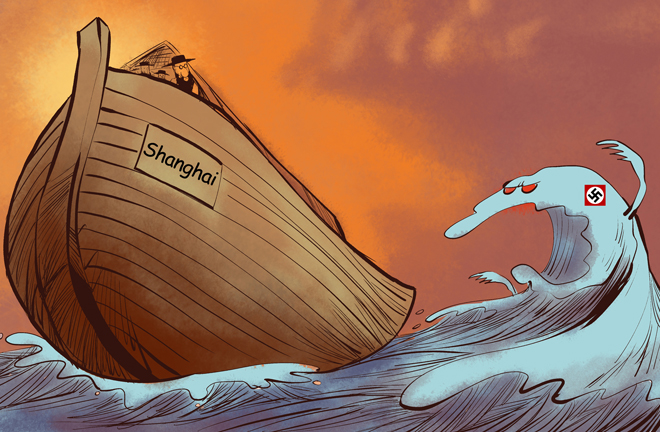Shanghai was ‘Noah’s Ark’ to Holocaust refugees

Shelter in the storm
Cartoon by Gou Ben; Poem by Long Yuan
Jews seeking shelter from a gathering storm,
Found in Shanghai a welcome warm,
A place of safety and refuge,
A “Noah’s Ark” amid the Great Deluge.
Chinese and Jews shared weal and woe,
And united together against a common foe.
Just as the refugees were grateful to the Chinese nation,
The Chinese thanked the Jews for help against Japanese invasion.
As one heads southeastward along Zhoushan Road past the Shanghai Jewish Refugees Museum, one can see a set of three-storey buildings closely linked to each other. These well-preserved houses were designed and built by early Jewish immigrants to for those who traveled to Shanghai to escape persecution in Europe.
Former US Treasury Secretary Werner Michael Blumenthal was among them. In his autobiography, he recalled that when his family first came to Shanghai, they lived in a small apartment at 59 Zhoushan Road. Four people shared 10 square meters of space and each slept in the corners. The early days after arriving in Shanghai were full of hardship, and it was an experience Blumenthal said he would never forget.
Over time, the refugees gradually adapted to life in Shanghai. Zhoushan Road has changed drastically since those days, and the tiny apartments that once offered shelter to Jewish refugees gave way to the homes of ordinary Shanghai people. Still, many locals can recall interacting with the Jews who used to live there, and their offspring often come back to Shanghai to visit their old homes.
“To give a better understanding of the Jews who lived in Shanghai, we designed a route called ‘Ark’s Road’ along which there are several representative historical sites that allow visitors to experience the history of Jewish refugees living in Shanghai,” said Chen Jian, director of the Shanghai Jewish Refugees Museum.
Tolerant Shanghai as asylum
Why did Shanghai become the “Noah’s Ark” that saved thousands of Jewish people during World War II? “The reasons were complex,” said Pan Guang, director of the Center for Jewish Studies at the Shanghai Academy of Social Sciences.
From a cultural perspective, China has never had a history of anti-Semitic sentiments or movements. The Chinese and Jewish cultural traditions are similar to each other in many ways. The racial prejudice and discrimination that Jews experienced in Europe due to cultural discrepancies were practically nonexistent in China. Living in China, Jews felt psychologically secure, while they had suffered widespread persecution in Europe.
After the Battle of Shanghai in 1937, Japanese invaders captured most areas of Shanghai and its vicinity. From 1937 to 1939, passport and visa procedures were in a state of chaos. Foreigners could easily enter Shanghai without a visa, economic insurance, stable jobs or the moral integrity certificate issued by the police, which provided opportunities for Jewish immigrants.
The economic hardships brought by World War II prompted many countries to set strict limits on immigration. Though home to the world’s largest Jewish community, the US also restricted the influx of Jewish refugees. To avoid disputes, many neutral countries rejected Jewish refugees, and some other countries were unable to help settle Jewish refugees due to severe financial problems.
At the évian Conference in France in 1938, all attending countries expressed their sympathy for the Jewish situation, but there was not a single country was explicitly willing to accept Jewish refugees. Facing certain death, the Europe’s Jews had to look East.
‘China’s Schindler’
Though Shanghai could be entered without a visa, a visa for the target country was required as proof of emigration before refugees could leave Nazi Germany. Known as the “Chinese Schindler,” Ho Feng-Shan, the former Chinese consul-general in Austria, saved more than thousands of Jews in Vienna in the 1930s.
In his memoir My Forty Years as a Diplomat, Ho Feng-Shan wrote this way: “The tragedy of massacre could be seen every day in the street, and even some Jews with high social status in Austria could not escape being persecuted. Therefore, for Jews in Austria, leaving meant living, while staying meant death.” When nearly all the country refused to give out visas to Jewish refugees, Ho saved thousands of Jewish people through issuing visas to Shanghai.
His humanitarian act only became known in 1997, when Ho passed away in San Francisco. His daughter mentioned in his obituary that Ho Feng-Shan had issued visas to China for the Jews, which was later studied by those Jews in America and historians. In 2001, a memorial exhibition titled Life Visa: Diplomats with Justice and Dignity was hosted at UN headquarters. Among those diplomats who had aided Jewish refugees, Ho was the only one from China, and he is credited with saving the most.
Jewish art
Jewish refugees established newspapers in many languages to foster communication with each other. Of Shanghai’s German-language newspapers, the Shanghai Jewish Chronicle lasted the longest and ceased publication in 1949, when Shanghai was emancipated. Israel’s Messenger founded in 1904 by the Sephardi Jewish businessman Nissim Elias Benjamin Ezra, and it was the oldest Shanghai Jewish community newspaper. After its publication suspended in 1941 due to financial problems and the flames of war, the Shanghai Jewish Chronicle became the main Jewish newspaper.
Among the German and Austrian Jewish refugees, there were many highly skilled artists, whose arrival enriched the cultural milieu of Shanghai. Ferdinand Adler, the German violinist, became the chief violinist of the Shanghai Municipal Orchestra and Band. He was joined by another Germany violinist named Alfred Wittenberg, who taught at the forerunner to the Shanghai Conservatory of Music and cultivated many outstanding Chinese students. In addition, the works of the Austrian Jewish painter Friedrich Schiff and the German Jewish David Ludwlg Bloch reflected the vicissitudes of the past Shanghai.
To this day, the lasting legacy of the Jewish diaspora can still be seen in many parts of Shanghai.
Li Yu and Zha Jianguo are reporters at the Chinese Social Sciences Today.
